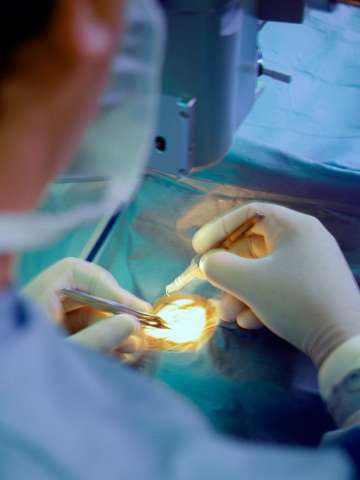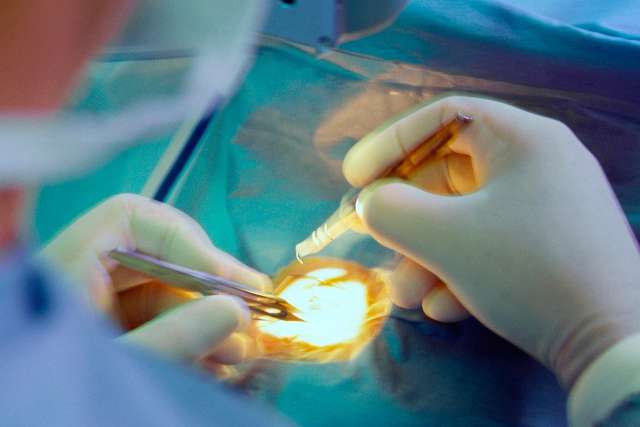Corneal Transplant
Our corneal transplant surgeons offer the full range of surgical techniques. We use advanced approaches that help you recover faster, with better vision.

Why choose UCLA Health for a corneal transplant?
UCLA Health Corneal Transplant Program experts use specialized experience and advanced technology to replace the damaged outer tissue of your eye (cornea). Our surgeons use the newest approaches to cornea transplant surgery for improved outcomes, so you heal faster and see better.
Highlights of our program include:
State-of-the-art techniques: We offer a range of advanced techniques for corneal transplants, which are the most common type of transplant surgery. Our surgeons use approaches that offer lower complication rates and faster visual recovery.
Expanded treatment options: Patients who are not candidates for traditional transplants may receive an artificial cornea transplant, in which we replace the damaged cornea with a manmade (prosthetic) one. These transplants offer a viable alternative to patients who previously had no hope of restoring their vision.
Research-driven care: As part of a renowned academic center, our physicians continually research and bring you the newest treatment techniques. We also offer eligible patients access to clinical trials of promising new therapies.
Skilled expertise: We are established experts in corneal transplantations. One of our surgeons has performed more than 100 artificial cornea transplants, placing him among the most experienced surgeons worldwide who do this procedure.
What is a corneal transplant?
A corneal transplant, also called a keratoplasty, is surgery to replace damaged corneal tissue.
The cornea is the transparent outer tissue of your eye. It allows light to pass through your eye so that you can see.
During a corneal transplant, the surgeon removes damaged corneal tissue and replaces it with healthy corneal tissue from a donor. Unlike solid organ transplants, corneal transplants don’t require tissue matching. Because of this, the wait time to find donor tissue is often shorter than for other types of transplants.
Who is a candidate for corneal transplant?
A cornea transplant may restore vision and decrease pain for patients who have corneal damage. You may have corneal damage due to:
- Corneal ulcers (sores) or scarring
- Fuchs’ dystrophy, an inherited (passed down in families) eye disease that causes corneal swelling and thickening
- Keratoconus, a bulging cornea
- Previous eye surgery complications
- Swelling or thickening of the cornea
- Thinning or tearing of the cornea
Types of corneal transplants we offer
Our corneal surgeons offer a range of techniques for corneal transplantation. Types of corneal transplants include:
Endothelial keratoplasty (EK): The surgeon removes tissue from the back portion of the cornea. These back layers include the endothelium, a thin membrane that lines the cornea, and the Descemet membrane, the layer of tissue that protects the endothelium. The two types of endothelial keratoplasty include:
- Descemet stripping endothelial keratoplasty (DSEK): The surgeon replaces the endothelium and Descemet membrane with donor tissue, along with a thin layer of supportive tissue called stromal tissue. This procedure removes and replaces about one-third of the cornea.
- Descemet membrane endothelial keratoplasty (DMEK): The surgeon replaces the endothelium and Descemet with a thinner layer of donor tissue than is used in the DSEK procedure. This tissue doesn’t include stromal tissue, so it’s much more fragile. This is the most complex type of EK due to the fragility of the donor tissue.
Anterior lamella keratoplasty (ALK): ALK removes and replaces only the diseased, outer layers of the corneal tissue, leaving the back layers intact. We may recommend this approach for patients have a corneal scar or keratoconus but a normal endothelium. We use two types of ALK, depending on how deep cornea damage extends into the eye tissue:
- Superficial anterior lamellar keratoplasty (SALK): The surgeon replaces only the front layers of the cornea and leaves the endothelium intact.
- Deep anterior lamellar keratoplasty (DALK): The surgeon goes deeper through the layers of corneal tissue, possibly replacing stromal tissue, the supportive tissue around the epithelium.
Keratoplasty with femtosecond laser: We may perform a keratoplasty with a laser. The laser makes incisions using ultra-fast energy pulses. This technique lets us shape incisions so the transplanted tissue fits precisely into the cornea. This approach results in faster recovery and less astigmatism (an imperfect curve in the eye). Femtosecond laser keratoplasty is best for patients who haven’t had a prior corneal transplant or incisional corneal surgery, and don’t have dense corneal scarring.
Penetrating keratoplasty: This is the traditional approach to a corneal transplant. The surgeon uses a round, bladed tool to make an incision through all the layers of the cornea. We remove the central portion of the cornea and replace it with healthy donor tissue.
Artificial corneal transplant: Artificial transplants expand options for patients who aren’t candidates for traditional approaches or who have experienced corneal transplant failure. In this procedure, the surgeon replaces the damaged cornea with a prosthetic cornea.
Meet the team
Our corneal transplant surgeons lead one of the most experienced, highest-volume corneal transplant teams in the nation. We are continually setting and raising the standard in expert corneal surgery. Our physicians use advanced techniques that offer you a quicker recovery and improved vision.
Our Expert Team - UCLA Stein Eye Institute Specialists

Contact us
Call to request an appointment with a corneal transplant specialist at UCLA Health.
Find your care
Our corneal transplant surgeons are some of the most experienced in the nation. Call to learn more about our corneal transplant services.




